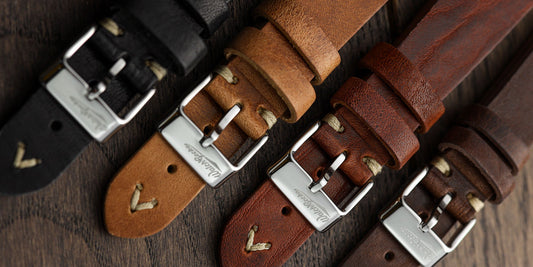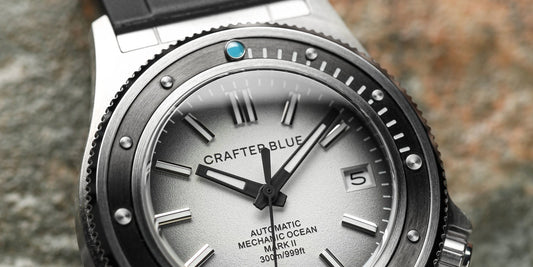I’ve interviewed a wide variety of society over the years, from royalty to bank robbers, but not once has the opening question ever been: “When did you first meet a gorilla?”
Yet it’s almost the foremost thing that comes to mind when you talk to French artist and Hublot brand ambassador Richard Orlinski, best known for his oversized geometric sculptures of wildlife; particularly gorillas. Or to be more accurate, King Kong: who he pays tribute to with his most famous statue – “a monster with a big heart”.
 Richard at Watches and Wonders 2023 - Credit WatchGecko
Richard at Watches and Wonders 2023 - Credit WatchGecko
The Frenchman has often been compared to Jeff Koons for the way that he has popularised and commercialised modern art, yet he has his own distinct approach. ‘Modern art’ is such a broad label these days that it almost defies description, but as art starts and finishes with its creator, it’s probably better to describe Orlinski as a thoroughly modern artist rather than his work just as ‘modern art’.
He’s been involved in cryptocurrency drops, has a dedicated atelier in Paris that pumps out an unstinting body of creations, and puts his name to boutiques in all the trendiest locations around the world, from Gstaad to Miami.
If you can’t afford an iconic gorilla statue, you can at least buy an Orlinski keyring. Or a shopping bag, or an IPhone case. Orlinski has made a phenomenally successful business out of art and become a quasi-rockstar in the process – but that’s not significantly different from what his Renaissance predecessors did, from Caravaggio onwards. There’s that swagger to Orlinski; an easy Gallic confidence that marks him out as a man of distinction.
He’s comfortable in his own skin, rumpled leather jacket, and with his own success. Many artists dream of international renown, but probably less than two per cent achieve it. On the one hand, Orlinski never assumed he would hit the heights that he has. Yet at the same time he says that success didn’t come as a complete surprise. “It’s what you aim for and work for, so why should it be a surprise?’ he points out. “Maybe it’s luck, but not a surprise. I don't believe in fairy tales.”
Yet had he not become so famous, Orlinski would have quietly continued to be an artist, probably teaching art as well, as he does today. Unlocking the key to fame though – tapping into the formula that elevates certain people from aspiring artist to international superstar – remains elusive. “If we all knew that; more people would do it…” he jokes.
But he has some thoughts and theories as to how it all happened for him. He believes that the key to success as an artist is to find something that makes you disruptive – and to be honest to yourself. Orlinski discovered his niche from an early age – making clay sculptures of elephants when he was just four – to lay down the roots of his “born wild” philosophy, which is centred around the visceral energy of animals.
“Born Wild is really about my thoughts on the relationship between humans and animals,” he explains. “We think that animals are silly and we are intelligent. You know, it always struck me that animals are killing for a good reason – eating – and we are killing for nothing. In other words, animals tend to follow a virtuous circle while we often follow a vicious circle. So maybe we can actually learn something from animals. This was really a concept I had at the very beginning of my career, and I always put that concept first as I was very shy and I didn't like to put myself in front.”

Richard at Watches and Wonders 2023 - Credit WatchGecko
Things are very different these days. Orlinski still has many animals “in the drawer” that he would still like to sculpt but he is also inspired by his Instagram followers – nearly six million of them, which is almost exactly the same number as Hublot themselves – to create specific ideas. Having started his career depicting wild animals, a gentler side is emerging He recently completed a tortoise and a butterfly. “In their own way, they are wild too,” Orlinski points out. “They are also about beauty and nature.”
His art is still all about expressing power within a static creation though and he manages to achieve this in an undeniably compelling way. Those King Kong gorillas feel like they are going to burst out at you while standing still; one of the reasons why Orlinski was commissioned to create the trophy for the French Formula 1 Grand Prix in 2019, for example.
And that fascinating paradox – movement within stillness – lies at the very heart of the intersection between art and watchmaking, according to Orlinski. He’s been a brand ambassador for Hublot since 2017, creating a number of watches that showcase his unique style – with perhaps the 45mm Aerofusion Chronograph Orlinski Red Ceramic being the best example. Just like his artwork, it’s instantly recognisable.

Hublot 45mm Aerofusion Chronograph Orlinski Red Ceramic - Credit Hublot
“To be honest, the partnership with Hublot is very easy, very natural,” he says. “We reinterpret the shape we have in my sculptures and put it in the watch case. We try to capture exactly the same energy and DNA. The only difference is that I work in macro and Hublot works in micro.”
Yet the more that you talk to him, the more you realise that Orlinski doesn’t really see things in black and white. His art is panoramic, as it’s not just about sculpture: he’s also a musician, a writer, and – more unexpectedly – a stand-up comedian. It’s this fringe art that he says gives him the biggest thrill of all, as it’s just you and the stage. There’s nowhere to hide and you live in the moment. Art can be enigmatic, sculptures can be elaborated, but you are either funny or you’re not, right now. And it’s this lateral approach to the whole process of creation that he believes makes him disruptive and different. Everything is the sum of its parts: including the collaboration with Hublot. “These things all bring you a global perspective,” is how he puts it. “When you’re comfortable the process of creation is easy, and the results are good.”
As a result, the partnership with Hublot is one of the things that the 57-year-old is most proud of. “It’s very nice to have your own watch, especially when it becomes such a big success,” he says. “At the Geneva show, so many people stopped me and wanted to talk and take photos and that’s not because they love me, but they love what I do, which is great. I love that people feel the sincerity of the purpose. Some people have never heard of me but they just like the watch or the art, which is also great. I want people to be free. To think what they want to think. I don’t want to impose anything.”
Some people might believe that the free-wheeling, creative, and inspirational world of art – which by definition has no frontiers – is diametrically opposed to the prescribed science of watchmaking, where precision, order, and method are key. But Orlinski sees it somewhat differently.

Stunning creations by Orlinski for Hublot - Credit Hublot
“The very first time I went to Hublot’s manufacture, my first thought was actually ‘oh, this is just like us!’ We have a similar way of working: machines, scouting, designing. The technical side is different, but watches give emotion and feeling: I know this as a collector myself. I think for men especially there’s a special relationship with a watch, as it’s the one piece of jewellery that most men have, while women tend to have more items. And I’ve always loved watches, of all types: vintage as well as modern. So it’s personal.”
The partnership with Hublot fits into that philosophy, as this is a modern watchmaker but with a certain history, having originally been founded back in 1980, and with its iconic Big Bang watch created by none other than the legendary Jean-Claude Biver. Rumour has it that Biver even wanted to buy the brand a few years back but couldn’t quite compete with the financial power of the LVMH Group: the current owners.
What originally attracted Biver to the brand was that these are forward-looking, avant-garde watches, which are nonetheless rooted in a permanent solidity consistently expressed throughout the design language. ‘Hublot’ means porthole in French, as this is what the screwed-in face of the watch resembles. A window onto the world, as well a means of measuring time. And that, in many ways, is exactly what art is too; playing an even more important role in our everyday lives as the world becomes more virtual and metaphysical, with the advent of artificial intelligence and the metaverse.
As humans, we probably now need anchoring more than ever, and this is what art – and Orlinski – is trying to give us. While he fused art with the digital world through NFT drops and tokens, you get the sense that the Frenchman is coming back in a full circle – as artists often do. Because art, in the end, is just a reflection of our times. So the relationship between an artist and a watchmaker is entirely symbiotic.
“You have to live in your time, but the physical world will never disappear,” concludes Orlinski. “We’ve already seen that so many virtual projects fade without a physical issue. So art will always be there for the future.”
As will time, as will animals. The world is still smaller, more real, and more natural than we think. But sometimes it takes an artist – as well as a watch brand – to remind us of that.
















